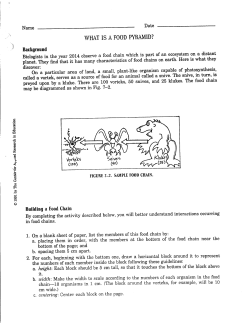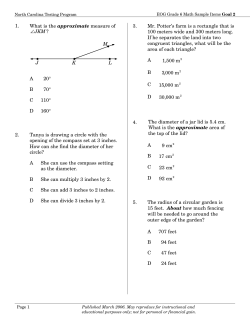
MENSURATION
MENSURATION Definition 1. Mensuration : It is a branch of mathematics which deals with the lengths of lines, areas of surfaces and volumes of solids. 2. Plane Mensuration : It deals with the sides, perimeters and areas of plane figures of different shapes. 3. Solid Mensuration : It deals with the areas and volumes of solid objects. Important Formulae Right Angled Triangle : (AC)2 = (AB)2 + (BC)2 or, h2 = p2 + b2 If AC = 5m, AB = 4m then (BC)2 = (AC)2 - (AB)2 = 25 – 16 = 9 BC = 3m Rectangle : A rectangle is a plane, Whose opposite sides are equal and diagonals are equal. Each angle is equal to 90˚. Here AB = CD; length l = 4m AD = BC; breadth b = 3m 1. Perimeter of a rectangle = 2(length + breadth) = 2(l + b) = 2(4 + 3) = 14 m 2. Area of rectangle = length x breadth = l x b = 4 x 3 = 12 m2 3. Length of a rectangle : = - breadth ] = ( or, [ Breadth of a rectangle : =4m -3)=4m = - length ] = ( or, [ = = =3m -4)=3m 4. Diagonal of rectangle : √ =√ =√ =√ =√ =5m Square : A square is a plane figure Bounded by four equal sides having all its angle as right angles. Here AB = BC = CD = AD = 5 m = a(Let) 1. Perimeter of square = 4 x sides = 4a = 4 x 5 = 20m 2. Area of a square = (sides)2 = a2 = (5)2 = 25 sq. m 3. Side of a square = √ = √ = 5m or, = =5m 4. Diagonal of a square = √ =√ 5. Side of a square = √ x side = √ a x 5 = 5√ m = √ √ = 5m Triangle : 1. Area of triangle = = x base x height = xbxh x 15 x 12 = 90 sq. cm here AD = 12 cm = height, BC = 15 cm = base 2. Semi perimeter of a triangle S= = = 12 cm here BC = a, AC = b, AB = c 3. Area of triangle = √ where a = 10cm, b = 8cm, c= 6cm, s= 12cm =√ =√ = 24 cm2 4. Perimeter of a triangle = 2s = (a + b + c) = 10 + 8 + 6 = 24 cm 5. Area of an equilateral triangle = = = √ √ √ 6. Height of an equilateral triangle = x (side)2 x (4√ )2 cm2 x 48 = 12√ √ x (side)2 = √ x 4√ = 6 cm 7. Perimeter of an equilateral triangle = 3 x (side) = 3 x 4√ = 12√ cm Quadrilateral : Parallelogram : (i) Area of parallelogram = base x height =bxh = 8 x 5 = 40 sq.cm. (ii) Perimeter of a parallelogram = 2(AB + BC) = 2( 8 + 5 ) = 26 cm Rhombus : (i) Area of rhombus = x (product of diagonals) = (ii) (d1 d2 ) = x 8 x 6 = 24 cm2 Perimeter of rhombus = 4 x side = 4a here AB = BC = CD = AD = 4a AC = d1, BD = d2 Trapezium : (i) Area if a trapezium = x ( sum of parallel sides) x height = x (a + b) x h = x ( 15 + 17) x 10 = x 32 x 10 = 160 cm2 Regular Hexagon : √ x (side)2 (i) Area of a regular hexagon = 6 x (ii) Perimeter of a regular hexagon = 6 x (side) Circle : (i) Circumference of a circle = 𝜋 x diameter = 𝜋 x 2r = 2𝜋r =2x x 42 = 264 cm (ii) Radius of a circle = = (iii) Area of a circle = 𝜋 x r2 = (iv) Radius of a circle = √ x 422 = =√ (v) = 42 cm x 42 x 42 = 5544 cm2 =√ 𝜋r2 = Area of a semi circle = = = 42 cm 𝜋d2 x 422 = 2772 cm2 x (vi) Circumference of semi circle = x 42 = 132 cm (vii) Perimeter of semi circle = (𝜋r + 2r) = (𝜋 + 2) r = (𝜋 + 2) (viii) Area of sector OAB = x 𝜋r2 (x being the central angle) = (ix) ˚ ˚ x x 3.5 x 3.5 = 3.21 sq. m. Central angle by arc AB = 360˚ x = 360˚ x (x) = (xi) ˚ Radius of circle = √ =√ = 30˚(approx) ˚ ˚ =√ Area of ring = difference of the area of two circle =√ = 3.5 m. = 𝜋R2 – 𝜋r2 = (R2 – r2) = 𝜋(R + r)(R – r) = (sum of radius)(diff. of radius) = × (4 + 3)(4 – 3) = ×7×1 = 22 sq. cm. Cuboid and Cube : (i) Total surface area of cuboid = 2(lb + bh + hl) sq. unit Here l = length, b = breadth, h = height = 2(12 × 8 + 8 × 6 + 6 × 12) = 2(96 + 48 + 72) = 2 × 216 = 432 sq. cm. (ii) Volume of a cuboid = (length × breadth × height) = lbh = 12 × 8 × 6 = 576 cuboic cm (iii) Diagonal of a cuboid = √ =√ =√ =√ (iv) Length of cuboid = = (v) Breadth of cuboid = = (vi) Height of cuboid = (vii) Volume of cube = (side)3 = = 123 = 1728 cubic cm Cube : All sides are equal = 12 cm (viii) Sides of a cube = √ =√ = 12 cm = 2√ cm. (ix) (x) Diagonal of cube = √ (side) = √ 12 = 12 √ cm 2 Total surface area of a cube = 6 × (side) = 6 × 122 = 864 sq.cm Right Circular Cylinder : (i) Area of curved surface = (perimeter of base) x height = 2𝜋rh sq. unit =2x (ii) x 7 x 15 = 660 sq. cm Total surface area = area of circular ends + curved surface area = 2𝜋r2 + 2𝜋rh = 2𝜋r(r + h) sq. unit =2x x 7(15 + 7) = 2 x 22 x 22 = 968 sq. cm. (iii) Volume = (area of base) x height = (𝜋r2) × h = 𝜋r2h = (iv) x 7 x 7 x 15 = 2310 cubic cm. Volume of a hollow cylinder = 𝜋R2h - 𝜋r2h = 𝜋h(R2 - r2) = 𝜋h (R + r)(R – r) = 𝜋 x height x (sum of radii)(difference of radii) Here R, r are outer and inner radii respectively and h is the height. Cone : (i) In right angled OAC, we have l2 = h2 + r2 (here r = 35 cm, l = 37 cm, h = 12 cm) Or, l = √ h=√ ,r=√ where l = slant height, h = height, r = radius of base (ii) Curved surface area = = = (iii) x (perimeter of base) x slant height x 2𝜋r x l = 𝜋rl sq. unit x 35 x 37 = 4070 sq. cm Total surface area S = area of circular base + curved surface area = (𝜋r2 + 𝜋rl) = 𝜋r(r + l) sq. unit = (iv) x 35( 37 + 35) = 7920 sq. cm Volume of cone = (area of base) x height = (𝜋r2) x h = = x 𝜋r2h cubic unit x 35 x 35 x 12 = 15400 cubic cm Frustum of Cone : 𝜋h(R2 + r2 + Rr) cubic unit (v) Volume of frustum = (vi) Lateral surface = 𝜋l(R + r) where l2 = h2 + (R – r)2 (vii) Total surface area = 𝜋[R2 + r2 + l(R + r)] R, r be the radius of base and top the frustum ABB’A’ h and l be the vertical height and slant height respectively. Sphere : Surface area = 4𝜋r2 (i) =4x x (10.5)2 = 1386 sq. cm here, d = 21 cm (ii) Radius of sphere = √ (iii) Diameter of sphere = √ (iv) Volume of sphere V = = x r = 10.5 cm =√ =√ 𝜋r3 = 𝜋( 3 = 10.5 cm = 21 cm = 𝜋d3 x 21 x 21 x 21 = 4831 cubic cm (v) Radius of sphere = √ (vi) Diameter = (vii) Volume of spherical ring = (viii) Curved surface of hemisphere = 2𝜋r2 (ix) Volume of hemisphere = (x) Total surface area of hemisphere = 3𝜋r2 √ 𝜋(R3 – r3) 𝜋r3 Note : V = volume, A = area, h = height, b = base,breadth, d= diameter, R = outer radius, r = inner radius, 𝜋 = = 3.142, a = side. Prism and Pyramid Prism 1. Solid : Bodies which have three dimensions in space are called solid. For example, a block of wood. A body, which has the three dimensions length, breadth and height, is a solid, whereas a rectangle with its two dimensions (length and breadth) is not a solid. 2. Prism : A prism is a solid, bounded by plane faces of which two opposite sides known as bases are parallel and congruent polygons. 3. Base : The congruent and parallel faces of a prism are called its bases. The other faces of a prism can be either oblique to the faces or perpendicular to them. 4. Right prism : A right prism is a prism in which lateral sides are rectangular or perpendicular to their bases. 5. Lateral faces : The side faces of a prism are called its lateral faces. 6. Lateral surface area : The area of all the lateral faces of a prism is called its lateral surface area. Note : In a right prism having polygons of n sides as bases. (i) (ii) (iii) (iv) the number of vertices = 2 the number of edges = 3n the number of lateral faces = (n + 1), and all the lateral faces are rectangular. Formulae (i) (ii) Volume of a right prism = (Area of its base) x height Lateral surface area of a right prism =(perimeter of its base) x height (iii) Total surface area of a right prism =(lateral surface area) + 2(area of the base) Pyramid 1. Pyramid : A solid of triangular lateral sides having a common vertex and plane rectilinear bases with equal sides is called pyramid. 2. Height of the pyramid : The length of perpendicular drawn from the vertex of a pyramid to its base is called the height of the pyramid. The side faces of pyramid form its lateral surface. 3. Regular pyramid : If the base of a pyramid is a regular figure i.e., a polygon with all sides equal and all angles equal, then it is called a regular pyramid. 4. Right pyramid : If the foot of the perpendicular from the vertex of a pyramid to its base is the centre of the base then it is called a right pyramid. 5. Slant height of a regular right pyramid : The slant height of a regular right pyramid is the length of the line segment joining the vertex to the mid-point of one of the sides of the base. 6. Tetrahedron : When the base of a right pyramid is a triangle, then it is called a tetrahedron. 7. Regular tetrahedron : A right pyramid with equilateral triangle as its base is called a regular tetrahedron.
© Copyright 2025


















